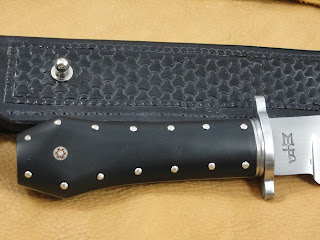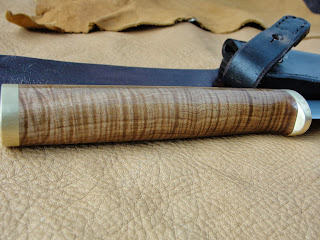It's a throw-caution-to-the-wind and do all the stuff I've been wanting to try project. I call it the Dog Seax because I carved fighting dogs on the sheath, and names are handy for talking about stuff. It's another seax (which is just a big medieval knife) in the Gotland style. It's 19" long with a 12" blade. It stays fairly true to some historical examples, but I did go somewhat afield on a few things.
The handle is two intertwined serpents, and it was my first attempt to carve stabilized wood. I was hoping that it would give me the best of both materials in terms of it's carving characteristics, but instead I got the worst. I still have to pay close attention to the grain direction of the wood, and the acrylic makes it harder to carve. Also the vacuuming process to get the wood completely saturated with the acrylic removes a lot of the moisture, so the net result is a brittle, hard to carve substance with grain you have to pay careful attention to. :-(
You can also see the second most obvious historical departure here - I put a bit of a guard on it. The whole concept of having a perfectly straight handle that allows your hand to slide up onto the blade scares me.
One of the other things I've been meaning to try is embossing leather. This isn't the best picture, but these are the fighting dogs I named it for. It was inspired by a viking carving, but the carving was a little too complex for my first try at leather so I did my own version of it. It came out ok, but there's still a lot I have to learn. The coloring and shading is proving especially tricky.
Details for knife aficionados: The blade was forged out of 1/4" 1084. Flat grind, fully hardened. There is basically no distal taper as you can probably tell from the photo. I put it through 2 hour-long tempering sessions at 400 degrees. The handle is stabilized maple with leather and brass washers. The tang goes all the way to the end of the handle, and I fastened the tang on this and my previous seax by insetting a washer into the handle, tapping the tang, and putting a nut on it like this:
Whittle tangs are more authentic but I just can't bring myself to do that. It's a weaker connection. The washers and the butt plate are then nailed & epoxied onto the end of the handle.
All the metal fittings are brass, and the designs are either stamped or scraped into the sheet brass. The leather is 8-10oz leather I got from Wickett & Craig in Pensylvania, and it's awesome. It seems to work much better than the Tandy leather, and it's cheaper. The only problem is they sell in whole hides, so you're buying in 25+ square feet increments.



















































